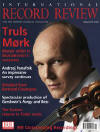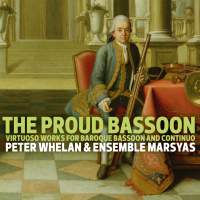Texte paru dans: / Appeared in:
*

International Record Review - (05//2014)
Pour
s'abonner / Subscription information
Linn
CKD435

Code-barres / Barcode :
0691062043526
Consultez toutes les évaluations recensées pour ce cd
~~~~ Reach all the evaluations located for this CD
This disc boasts excellent sound engineering. Recorded in the Wigmore Hall in London, a modern concert venue whose light reverberation approaches the acoustic of an eighteenth‑century wood‑and‑plaster‑lined hall, the sound is strikingly immediate, with each instrument precisely located within the soundstage. My only quibble is that the instruments may be a touch too closely miked so as to slightly obscure the Hall's acoustic. While the standard CD version of the recording on this hybrid disc is clear enough, the SACD highresolution version also on the disc reveals a little more of the space around the musicians and especially benefits the richly textured sound (and clacking keys) of Peter Whelan's Baroque bassoon. Whelan and his Ensemble Marsyas have selected chamber pieces from about 1725 to 1750, some well known and others quite obscure, all of which they perform with forthright energy and vitality. The disc opens with familiar works in unfamiliar garb: Jean Philippe Rameau's dances, Les sauvages and Tambourin, are well known both as solo harpsichord pieces and in later orchestral versions in his opéra‑ballets, Les Indes Galantes (1736), and Les fêtes d’Hébé (1739). Whelan plays arrangements from a mid‑eighteenth-century Parisian publication by the Leclerc brothers entitled Les Gentils Airs ‑ ou Airs Connus, ajustée en duo pour deux violoncelles, bassons ou violes. As the title page explains, they can also be played on one bass instrument with harpsichord accompaniment, since the second instrument is considerably less difficult than the first. Whelan and his team have adopted this second option, with Thomas Dunford's lute and Sarah McMahon's cello providing additional support alongside Philippe Grisvard's harpsichord.
Les sauvages is taken at a brisk pace, with an infectious lilt and some rapid diminutions, which Whelan delivers with effortless fluency. The brief Tambourin is played with similar vigour and brilliance. In between is a longer, gentler piece, Lafurstemberg, which was probably a folk song originally, but was popularized as a solo harpsichord piece by Michel Corrette, who may also have been responsible for all the arrangements in the collection. The disc also ends with an arrangement of a folk tune. Handel's first violinist in Dublin, Matthew Dubourg, arranged the popular Irish tune Eileen Aroon for bassoon and basso continuo for a concert in 1745. Although this arrangement has not survived, Whelan has adapted for his instrument Dubourg's solo harpsichord setting, which he found in the National Library of Ireland. Once again, Whelan provides a sparkling account of the work.
Like the three opening pieces, the two engaging Op. 50 Sonatas by Joseph Bodin de Boismortier (a fine composer undervalued both in his own time and today) were not written primarily for the bassoon. As with Les Gentils Airs, Boismortier's title page gave the bassoon only second billing and he most likely wrote them primarily with the cello in mind. Hervé Niquet's Le Concert Spirituel used that instrument for its recording of the G major Sonata No. 2. In fact, although Geoffrey Burgess's generally informative programme notes suggest otherwise, only two works on the disc were composed expressly for the bassoon: Johann Friedrich Fasch's Sonata in C major (FaWVN:Cl), his only solo one for the instrument; and Telemann's Sonata in F minor (TWV41:fl) from Der Getreue Music Meister, which has often appeared on disc as a recorder sonata, an alternative suggested in a footnote by Telemann.
Again, Whelan and his colleagues deliver full‑blooded and highly virtuosic accounts of the Boismortier, Fasch and Telemann. The slow movements are appropriately gentle too; but they perhaps fall a little short in tenderness or melancholy (particularly Telemann's wonderful opening movement, marked 'Triste'). Alain Gervreau on Baroque cello with Niquet is gentler and more emotionally complex than Whelan, whose account of the Boismortier is by turns more lugubrious and more robust. In the Fasch, the Italian Baroque bassoonist Sergio Azzolini finds more poetry than Whelan in the opening Largo and gorgeous third‑movement Andante, and he also ornaments more liberally and with great flair. In the Telemann, Jérémie Papasergio not only conveys greater emotional depth than Whelan but his instrument has a silkier, more evocative tone, perhaps owing to his reconstruction of historical reed‑making practices and historical fingering.
Yet, none of this detracts seriously from the supremely agile, spirited and good‑humoured performances of Whelan and Ensemble Marsyas. Where the musicians have gone wrong, however, is in the Treizième Concert from François Couperin's Les Goûts Réunis of 1724. It was written for 'two instruments in unison', meaning two (unspecified) instruments of the same range. It is usually played on flutes, recorders or violins. Ensemble Marsyas's version on bassoon and cello with lute and harpsichord continuo sounds opaque, with much detail of Couperin's subtle and delicately ornamented writing obscured.
Despite
this little mis‑step, I have no hesitation in recommending this very
attractive recording.
Fermer la fenêtre/Close window
Cliquez l'un ou l'autre
bouton pour découvrir bien d'autres critiques de CD
Click either button for many other reviews


